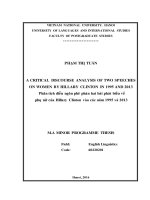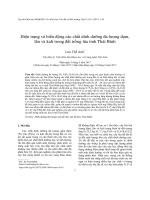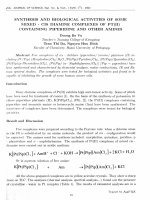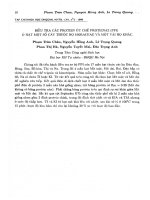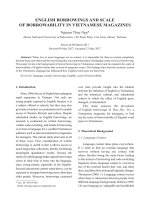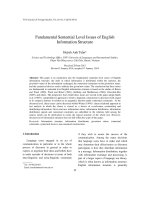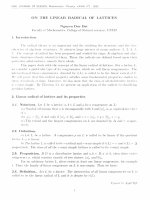DSpace at VNU: Deterministic Joint Remote Preparation of an Arbitrary Qubit via Einstein-Podolsky-Rosen Pairs
Bạn đang xem bản rút gọn của tài liệu. Xem và tải ngay bản đầy đủ của tài liệu tại đây (427.53 KB, 10 trang )
Int J Theor Phys (2012) 51:2272–2281
DOI 10.1007/s10773-012-1107-9
Deterministic Joint Remote Preparation of an Arbitrary
Qubit via Einstein-Podolsky-Rosen Pairs
Cao Thi Bich · Nung Van Don · Nguyen Ba An
Received: 11 October 2011 / Accepted: 14 February 2012 / Published online: 1 March 2012
© Springer Science+Business Media, LLC 2012
Abstract Joint remote state preparation is a secure and faithful method based on local operation and classical communication to transmit quantum states without the risk of full information leaking to either of the participants. In this work, we propose a new deterministic
protocol for two parties to remotely prepare an arbitrary single-qubit state for a third party
using two Einstein-Podolsky-Rosen pairs as the nonlocal resource. We figure out the advantages as well as the disadvantages of this new protocol in comparison with others, showing
in general that the proposed protocol is superior to the existing ones. We also describe the
situation when there are more than two preparers.
Keywords Joint remote state preparation · EPR pairs · Feed-forward measurements · Unit
success probability
1 Introduction
About three decades ago questions such as “Why one cannot precisely measure two conjugate variables at the same time?”or “Why an arbitrary quantum state cannot be cloned?” or
“Why there is spooky action at distance?”, etc., were regarded as idle. The loath answer at
that time was likely “God only knows”. Nowadays, perhaps because of “God is subtle but
malicious he is not”, people have become aware that such weird features, which are laws of
Nature, constitute the very necessary ingredients to guarantee absolute cryptography [1], to
exponentially speed up computation [2] or to perform a global task only by means of local
operation and classical communication (LOCC), etc.
C.T. Bich ( ) · N.V. Don · N.B. An
Center for Theoretical Physics, Institute of Physics, 10 Dao Tan, Hanoi, Vietnam
e-mail:
C.T. Bich
Physics Department, Hanoi University of Education No. 1, 136 Xuan Thuy, Hanoi, Vietnam
N.V. Don
Physics Department, Hanoi University of Science, 334 Nguyen Trai, Hanoi, Vietnam
Int J Theor Phys (2012) 51:2272–2281
2273
In quantum cryptography [1] information is encoded in classical keys which are however
distributed in a quantum way under the enemy’s very nose√by sending qubits prepared
ran√
domly in one of the four states {|0 , |1 , |+ = (|0 + |1 )/ 2, |− = (|0 − |1 )/ 2}, with
{|0 , |1 } the two orthonormal states of a qubit in the computational basis. Information can
also be encoded quantumly in the state of a qubit of the form
|
= a|0 + beiϕ |1 ,
(1)
with any parameters a, b, ϕ ∈ R satisfying the normalization condition a + b = 1. Nevertheless, transmitting quantum information by physically sending such informative qubits is
dangerous since any unauthorized parties can alter the qubits before they reach the intended
party without detection of the latter. Therefore, secure and faithful transmission of quantum
information without sending the qubits themselves proves to be a great idea. This implicitly means that the transmission should be performed by LOCC, which appears realizable
if some nonlocal resource is provided between the sending and the receiving parties. The
first intriguing protocol of such kind of global tasks, called quantum teleportation (QT), was
proposed in 1993 by Bennett et al. [3] using the quantum entanglement [4] as the nonlocal resource. In principle, by QT any unknown quantum states can be transmitted (see, e.g.,
[5–10] and references therein), if the transmitter owns the states. Yet, transmission of known
states can be done by a simpler method with the same nonlocal resource as in QT but without
the need of having the states at hand. This method was referred to as remote state preparation (RSP) [11–14]. As a per se feature of RSP, the preparer knows the full information
encoded in the to-be-prepared quantum state, that may appear unwanted in some circumstances. To avoid this feature, joint remote state preparation (JRSP) protocols [15–30] have
recently been designed, in which there are N ≥ 2 preparers [19], who jointly perform the
task but no one among them is able to identify the full content of the encoded information.
Experimental architecture of JRSP has also been dealt with in Ref. [31].
In this work we concentrate on JRSP of an arbitrary qubit state of the most general form
as in (1). In fact, such a problem was studied previously [15–18]. The nonlocal resource employed in Refs. [15, 16] was a single Greenberger-Horne-Zeilinger (GHZ) trio [32], while
it was two Einstein-Podolsky-Rosen (EPR) pairs [34] in Ref. [16] and one W state [33] in
Ref. [17]. However, all those cited protocols were probabilistic, i.e., they succeed just with
−1
a probability Psuc < 1. As the overhead expenses in resources scales with Psuc
, on average,
if several protocols use the same amount/kind of resource, then the better is the one that has
a greater success probability and, of course, the best one it that having Psuc = 1. Although
GHZ trios and W states are also useful (see. e.g. Refs. [15, 17]), we aim at employing EPR
pairs as the nonlocal resource because these are the most elementary kind of entanglement
and their production/distribution is easier than those of GHZ trios and W states. For joint
remote preparation of state |
in (1) two EPR pairs are necessary [16, 18]. In Ref. [16]
Psuc < 1, while in Ref. [18] Psuc = 1. Here we shall propose a different protocol which also
uses two EPR pairs as the nonlocal resource and has Psuc = 1 but offers pronounced advantages. From an application point of view, our work would reveal diversity and flexibility in
the ways a quantum task can be done given the same physical resource.
In the next section we present in detail our protocol for the case of N = 2 preparers.
Then, in the conclusion section, we compare it with other existing protocols to expose its
merit. We also provide an Appendix to deal with the generalization to any N > 2 preparers.
2
2
2 Our Protocol
Consider the simplest case of N = 2. The two preparers are Alice and Bob, while the receiver’s name is Charlie. The full information contained in state | , (1), is S = {a, b, ϕ},
2274
Int J Theor Phys (2012) 51:2272–2281
which can be somehow divided into S1 and S2 in such a way that S cannot be inferred from
either S1 or S2 , but can from both. Let S1 be given only to Alice, S2 only to Bob, but no
information to Charlie.
The two EPR pairs |EPR AC |EPR BC used in Refs. [16, 18] have the qubits’ distribution
shown in Fig. 1, i.e., qubit A belongs to Alice, qubit B to Bob and qubits C, C to Charlie.
Here, we adopt the notation
|EPR
XY
1
= √ |00 + |11
2
XY
.
(2)
The protocol in Ref. [16] is a two-step one. The first step is called the preparation step
and the second the reconstruction one. In the preparation step Alice (and independently
Bob) measures her (his) own qubit in a basis determined solely by S1 (S2 ), then publicly
broadcasts their outcome. In the reconstruction step Charlie first performs a controlled-NOT
gate1 on her two qubits, followed by measuring one of them in the computational basis. In
a lucky case when Charlie’s measurement outcome “matches” those of Alice and Bob, she
will apply a proper operator on her unmeasured qubit to reconstruct it into the desired state.
Although there are many ways to divide S into S1 and S2 [15–17], neither one can make the
protocol in Ref. [16] deterministic. Its maximum success probability is just Psuc = 1/2.
The protocol in Ref. [18] uses the same nonlocal resource with the same qubits’ distribution as in Fig. 1 (i.e., as in Ref. [16]), but it is deterministic. To achieve Psuc = 1 it was
designed to be a three-step (not two-step) one: there are two preparation steps and one reconstruction step. In the first preparation step Bob does nothing, Alice does the same thing
as in Ref. [16] and, at the same time, Charlie performs a controlled-NOT gate on her two
qubits, followed by measuring one of them in the computational basis, but postpones application of any operators on the unmeasured qubit. Then, both Alice and Charlie openly
announce their measurement outcomes. In the second preparation step Bob starts his action
by measuring his qubit in a basis that is judiciously determined by him, making use not only
of S2 but also of the concrete outcomes announced by Alice and Charlie in the first step.
After the measurement, Bob publishes his outcome via a classical communication channel
as well. What remains in the last step (i.e., the reconstruction step) is Charlie’s application
on the untouched qubit of the right operator conditioned on the outcomes of both Alice and
Bob. Note that the division of S into S1 and S2 in Ref. [18] should be
S1 = {a, b}
(3)
S2 = ϕ.
(4)
and
After a condensed summary of the protocols in Refs. [16, 18], our purpose here is to
propose a new deterministic protocol that also uses two EPR pairs but relaxes the function
of Charlie. The state of nonlocal resource employed in the new protocol is |Q ABA C =
|EPR AB |EPR A C with the qubits’ distribution shown in Fig. 2 which is remarkably different
from that in Refs. [16, 18]. Now, Alice holds two qubits A and A , while Bob and Charlie
each holds just a qubit (B and C). We also adopt the division S ⇒ {S1 , S2 } as in (3), (4) and
the new protocol is a three-step one as well. However, it proceeds differently as follows.
1 Controlled-NOT gate denoted by CN OT
XY is a quantum gate acting on two qubits X (control qubit) and Y
(target qubit) as CN OTXY |i X |j Y = |i X |i ⊕ j Y , where i, j ∈ {0, 1} and ⊕ stands for an addition mod 2.
Int J Theor Phys (2012) 51:2272–2281
2275
Fig. 1 The qubits’ distribution
for JRSP of the most general
single-qubit state via two EPR
pairs following the protocols
proposed in Refs. [16, 18].
Qubits are represented by dots
and entangled qubits are
connected by solid lines
Fig. 2 The qubits’ distribution
for JRSP of the most general
single-qubit state via two EPR
pairs following the protocol
proposed in this work. Qubits are
represented by dots and
entangled qubits are connected
by a solid line
In the first preparation step only Alice plays a role. She measures qubits A and A in the
basis determined solely by S1 = {a, b} as
⎛
|u00
⎜ |u01
⎜
⎝ |u10
|u11
⎞
AA
AA
AA
AA
⎛
|00
⎟
⎜
⎟ = U (a, b) ⎜ |01
⎠
⎝ |10
|11
⎞
AA
AA
AA
AA
⎟
⎟,
⎠
(5)
2276
Int J Theor Phys (2012) 51:2272–2281
with
⎛
a
⎜b
⎜
U (a, b) = ⎝
0
0
0
0
a
−b
⎞
b
−a ⎟
⎟,
0 ⎠
0
0
0
b
a
(6)
and publicly publishes kl (k, l ∈ {0, 1}), if the outcome |ukl AA is found. Since the transformation U (a, b) is unitary, the states {|ukl AA } constitute an orthonormal complete set in a
4D Hilbert space. Inversing (5) yields
|00
AA
= a|u00
AA
+ b|u01
AA
,
(7)
|01
AA
= a|u10
AA
− b|u11
AA
,
(8)
|10
AA
= b|u10
AA
+ a|u11
AA
|11
AA
= b|u00
AA
− a|u01
AA
(9)
and
.
(10)
As is well known, thanks to the effect of entanglement swapping, after Alice completed her
measurement the two qubits B and C are projected onto an entangled state, despite they are
far apart and still untouched. This is verified mathematically by substituting (7)–(10) into
the expression of the two EPR pairs in use |Q ABA C = |EPR AB |EPR A C , which can then
be rewritten in the form
|Q
ABA C
1
2
=
1
1
|ukl
AA
|Lkl
BC
(11)
l=0 k=0
where
|L00
BC
= a|00
BC
+ b|11
BC ,
(12)
|L01
BC
= b|00
BC
− a|11
BC ,
(13)
|L10
BC
= a|01
BC
+ b|10
BC
(14)
and
|L11
BC
= −b|01
BC
+ a|10
BC .
(15)
In the second preparation step only Bob plays a role. He measures the qubit B but the
choice of measurement basis is delicate. To achieve Psuc = 1, Bob must make use not only
of S2 = ϕ, which he is supposed to know, but also of the Alice’s outcome kl, which he hears
from the public media. It turns out, however, that only ϕ and l suffice. Explicitly, if l = 0,
Bob chooses the measurement basis as
1
1 e−iϕ
|0 B
|v0 B
=√
,
(16)
iϕ
|v1 B
e
−1
|1 B
2
whereas if l = 1, he chooses the measurement basis as
|v0
|v1
1
1
eiϕ
|0 B
=√
.
(17)
−iϕ
e
−1
|1
B
B
2
Combining (16) and (17), Bob’s measurement bases are determined by ϕ and l in the following fashion:
B
|v0(l)
|v1(l)
B
B
= V (l) (ϕ)
|0
|1
B
B
,
(18)
Int J Theor Phys (2012) 51:2272–2281
2277
Table 1 The collapsed state | klm C of Charlie’s qubit C and her reconstruction operator Rklm , depending
on the outcomes kl and m of Alice and Bob, respectively. I is the identity operator, X = {{0, 1}, {1, 0}} the
bit-flip operator and Z = {{1, 0}, {0, −1}} the phase-flip one
#
klm
| klm C
Rklm
1, 2
000 or 111
I
3, 4
011 or 100
a|0 C + beiϕ |1 C
a|1 C + beiϕ |0 C
5, 6
010 or 101
ZX
7, 8
001 or 110
a|1 C − beiϕ |0 C
a|0 C − beiϕ |1 C
X
Z
where
1
V (l) (ϕ) = √
2
e−(−1) iϕ
−1
l
1
e
(−1)l iϕ
.
(19)
Obviously, for a given l, the states {|vm(l) B ; m = 0, 1} constitute an orthonormal complete set in a 2D Hilbert space because V (l) (ϕ) is a unitary transformation. In terms of
{|v0(l) B , |v1(l) B }, we have
|0
B
1
= √ |v0(l)
2
|1
B
1
l
= √ e(−1) iϕ |v0(l)
2
+ e−(−1) iϕ |v1(l)
l
B
(20)
B
and
B
− |v1(l)
B
.
(21)
In measuring the quit B, if Bob finds it in state |vm(l) B , he reveals m ∈ {0, 1} publicly. Using
(20) and (21) in (12)–(15) we see that, conditioned on the outcomes klm, Charlie’s qubit C
would collapse, up to a global phase factor, into a certain state labeled | klm C , all of which
are collected in Table 1.
In the last step only Charlie plays a role. She makes use of the outcomes klm announced
by Alice and Bob to decide the right operator Rklm to be applied on her qubit C to cast it to
the target state | C . The concrete operators Rklm are also listed in Table 1. It is interesting
that we can express the dependence of Rklm on klm by a single compact formula as
Rklm = Z l⊕m X k⊕l ,
(22)
where ⊕ denotes an addition mod 2.
The probability for Alice finding state |ukl AA and Bob finding state |vm(l) B is Pklm = 1/8,
independent of concrete values of k, l and m. Since there exists a reconstruction operator for
each of the eight possible outcomes, our protocol succeeds with the total probability
1
1
1
Psuc =
Pklm = 8 ×
m=0 l=0 k=0
1
= 1,
8
(23)
i.e., it is deterministic.
3 Conclusion
We have reconsidered the problem of joint remote preparation of an arbitrary qubit. Although this problem was dealt with previously, the present investigation exhibits enlightening aspects. The nonlocal resource in terms of a GHZ trio and a W state was employed
2278
Int J Theor Phys (2012) 51:2272–2281
for the task in Ref. [15] and Ref. [17], respectively. In this work we instead concentrate on
two EPR pairs as the nonlocal resource, which were already employed in Refs. [16, 18].
The nice feature of the protocol in Ref. [16] is that the receiver participates only in the last
step and his function is just to reconstruct the target state without the need of classical communication. It however suffers a bad feature of being probabilistic (i.e., Psuc < 1). As for
the protocol in Ref. [18], the nice feature is that it is deterministic (i.e., Psuc = 1). On the
other hand, its bad feature is that the receiver’s function is more involved: she participates
not only in the last step but also in the first preparation step in which she is required to perform a controlled-NOT gate and to carry out a measurement as well as to communicate his
measurement outcome. As described in detail in the preceding section, the present protocol,
though being executed also via two EPR pairs, incorporates the nice features of both the
protocols in Refs. [16, 18]. That is, in the new protocol both Psuc = 1 and simple function
of the receiver are achieved. The only price to pay is the first preparer’s ability to carry out
a two-qubit measurement instead of just a single-qubit one as in Refs. [16, 18]. This price is
regarded cheaper than that spent by the receiver in Ref. [18]. Moreover, an additional advantage of the present protocols over those in Refs. [16, 18] rests in the symmetry between Bob
and Charlie (compare Figs. 1 and 2). Hence, this new protocol allows, in case of need, to
exchange the role of Bob and Charlie, while the other protocols do not. Concerning classical
communication cost, it is two bits in the probabilistic protocol [16]. As for those in Ref. [18]
and here, an extra bit arises, but this is worth to make them deterministic.
To conclude, we emphasize that to achieve unit success probability, Psuc = 1, the protocol
should consist of three steps (two preparation steps and a reconstruction step) and, more
importantly, feed-forward measurements should be done in the two first steps. Namely, the
basis for the measurement in the second step should be decided by the measurement outcome
in the first step.
Last but not least we would like to mention two meaningful issues. The first one concerns the question “What if the quantum channel initially consists of partially entangled
qubit-pairs?” and the second one asks “How about the situation of more than two preparers?” Of course partially entangled quantum channels can also do the job (usually with
auxiliary qubits and measurements on them), but only in a probabilistic manner. Maximum
entanglement is therefore a prerequisite for determinism of JRSP protocols. If it were not so,
a priori local filtering [35] or distillation process [36] is required to supply the participants
with (maximally entangled) EPR pairs. As for the situation of any N > 2 preparers, the procedure is somewhat nontrivial, very different from Ref. [19] and, thus, deserves a separate
description in the Appendix.
Acknowledgements We thank the two anonymous referees for their suggestions that improved the
manuscript. This work is supported by the Vietnam Foundation for Science and Technology Development
(NAFOSTED) through a project no. 103.99-2011.26.
Appendix
In this Appendix we generalize the situation with two preparers (Alice and Bob) described
in the main text to that with an arbitrary N > 2 preparers (Alice, Bob 1, Bob 2, . . . and Bob
N − 1). The pre-shared quantum channel consists of N EPR pairs distributed among the
N + 1 participants (N preparers plus a receiver) as shown in Fig. 3.
For clarity, let us first consider N = 3 in detail. The three EPR pairs of the quantum
channel are |EPR A1 B1 |EPR A2 B2 |EPR A3 C = |Q A1 B1 A2 B2 A3 C , with qubits A1 , A2 , A3 hold
by Alice, B1 by Bob 1, B2 by Bob 2 and C by the receiver Charlie. While Alice is allowed
Int J Theor Phys (2012) 51:2272–2281
2279
Fig. 3 The qubits’ distribution
for JRSP of the most general
single-qubit state via N EPR
pairs for the situation of N
preparers (Alice, Bob 1, Bob 2,
. . . and Bob N − 1). Qubits are
represented by dots and
entangled qubits are connected
by a solid line
to know {a, b} as in the case of N = 2, Bob 1 and Bob 2 now share the knowledge of ϕ in
the following way: Bob 1 knows ϕ1 and Bob 2 knows ϕ2 where ϕ1 and ϕ2 sum up to ϕ.
First, Alice measures her three qubits in the basis {|uklm A1 A2 A3 ; k, l, m ∈ {0, 1}}:
⎛
⎞ ⎛
⎞
⎞⎛
|u000 A1 A2 A3
a 0 0 0 0 0
0
b
|000 A1 A2 A3
⎜ |u001 A A A ⎟ ⎜ b 0 0 0 0 0
⎟
⎜
0 −a ⎟
1 2 3 ⎟
⎜
⎜
⎟ ⎜ |001 A1 A2 A3 ⎟
⎜ |u010 A A A ⎟ ⎜ 0 a 0 0 0 0
⎟ ⎜ |010 A A A ⎟
b
0
1 2 3 ⎟
1 2 3 ⎟
⎜
⎜
⎟⎜
⎜ |u011 A A A ⎟ ⎜ 0 b 0 0 0 0 −a 0 ⎟ ⎜ |011 A A A ⎟
1 2 3 ⎟
1 2 3 ⎟
⎜
⎜
⎟
⎜
⎜ |u100 A A A ⎟ = ⎜ 0 0 a 0 0 b
⎟ (24)
⎜
0
0 ⎟
1 2 3 ⎟
⎜
⎜
⎟ ⎜ |100 A1 A2 A3 ⎟
⎜ |u101 A A A ⎟ ⎜ 0 0 b 0 0 −a 0
⎟
⎜
0 ⎟ ⎜ |101 A1 A2 A3 ⎟
1 2 3 ⎟
⎜
⎟
⎜
⎝ |u110 A A A ⎠ ⎝ 0 0 0 a b 0
0
0 ⎠ ⎝ |110 A1 A2 A3 ⎠
1 2 3
|u111 A1 A2 A3
|111 A1 A2 A3
0 0 0 −b a 0
0
0
and publicly broadcasts klm, if she finds state |uklm A1 A2 A3 , projecting qubits B1 , B2 and
C onto an entangled state |Lklm B1 B2 C . Expressing the quantum channel |Q A1 B1 A2 B2 A3 C
through {|uklm A1 A2 A3 },
1
|Q
we derive |Lklm
A1 B1 A2 B2 A3 C
B1 B2 C
1
1
= √
2 2 m=0 l=0
1
|uklm
A1 A2 A3 |Lklm B1 B2 C ,
(25)
k=0
in the form
|L000
B1 B2 C
= a|000
|L001
B1 B2 C
= −a|111
|L010
B1 B2 C
= a|001
|L011
B1 B2 C
= −a|110
|L100
B1 B2 C
= a|010
|L101
B1 B2 C
= −a|101
|L110
B1 B2 C
= a|011
B1 B2 C
+ b|111
B1 B2 C
B1 B2 C
B1 B2 C
B1 B2 C ,
B1 B2 C ,
+ b|010
+ b|100
B1 B2 C ,
B1 B2 C ,
+ b|001
+ b|101
B1 B2 C
B1 B2 C
+ b|000
+ b|110
B1 B2 C
B1 B2 C ,
B1 B2 C ,
B1 B2 C
(26)
(27)
(28)
(29)
(30)
(31)
(32)
2280
Int J Theor Phys (2012) 51:2272–2281
and
|L111
B1 B2 C
= a|100
B1 B2 C
− b|011
(33)
B1 B2 C .
Next, Bob 1 and Bob 2 independently measure their qubits in a basis conditioned not
only on ϕ1 and ϕ2 but also on Alice’s outcome. Concretely, when klm = 000 or 010, each
Bob j (j = 1, 2) uses a measurement basis determined by
|v0
|v1
Bj
Bj
= V (0) (ϕj )
|0
|1
Bj
(34)
,
Bj
with V (0) (ϕj ) given in (19). However, for klm = 001 or 011, the basis for each Bob j is
|v0
|v1
Bj
Bj
= V (1) (ϕj )
|0
|1
Bj
(35)
,
Bj
with V (1) (ϕj ) given in (19). In case klm = 100 or 110, Bob 1 uses the basis
|v0
|v1
B1
|v0
|v1
B2
B1
= V (0) (ϕ1 )
|0
|1
B1
= V (1) (ϕ2 )
|0
|1
B2
,
(36)
.
(37)
B1
but the basis for Bob 2 is
B2
B2
Finally, if klm = 101 or 111, the bases for Bob 1 and Bob 2 are differently defined as
|v0
|v1
= V (1) (ϕ1 )
|0
|1
= V (0) (ϕ2 )
|0
|1
B1
B1
B1
(38)
B1
and
|v0
|v1
B2
B2
B2
(39)
,
B2
respectively. Then the states |Lklm B1 B2 C in (25) can be, up to an unimportant global phase
factor, decomposed in terms of {|vn B1 , |vs B2 } as follows
|Lklm
B1 B2 C
=
1
2
1
1
|vn
+
B1 |vs B2 Rklmns |
C,
(40)
s=0 n=0
with Rklmns either the identity operator or a Pauli one. This implies that after Alice, Bob 1
and Bob 2 announce their measurement outcomes, Charlie will be able to convert the qubit
C to be in the desired state | C by applying Rklmns on C. The reconstruction operators
Rklmns that Charlie needs in the last step are shown in Table 2. Because each of the 25 =
32 possible outcomes klmns is associated with a reconstruction operator Rklmns , the total
success probability is obviously 1.
As inferred from the cases of N = 2 and N = 3, for any N > 3 the quantum channel should consist of N EPR pairs, |Q A1 B1 A2 B2 ...AN−1 BN−1 AN C = |EPR A1 B1 |EPR A2 B2 . . .
|EPR AN−1 BN−1 |EPR AN C (see Fig. 3). The information is split in such a way that Alice still
knows {a, b}, but Bob j (j = 1, 2, . . . , N − 1) just knows ϕj in such a way that the constraint N−1
j =1 ϕj = ϕ is satisfied. The basis for Alice to measure N qubits A1 , A2 , . . . , AN
is spanned by 2N orthonormal states {(−1)i1 a|i1 i2 . . . iN A1 A2 ...AN + b|i1 i2 . . . iN A1 A2 ...AN ;
in ∈ {0, 1}; in = 1 − in }. As for Bob j , each of them independently measures qubit Bj in
the basis V (0) (ϕj ).{|0 Bj , |1 Bj } or V (1) (ϕj ).{|0 Bj , |1 Bj }, depending on Alice’s outcome.
Such generalized JRSP protocol works deterministically since for each of the 22N−1 possible measurement outcomes of the N preparers there exists a corresponding reconstruction
operator for the receiver to obtain the target state | C .
Int J Theor Phys (2012) 51:2272–2281
2281
Table 2 The reconstruction operator Rklmns , conditioned on the measurement outcomes klm, n and s of
Alice, Bob 1 and Bob 2, respectively. I is the identity operator, X = {{0, 1}, {1, 0}} the bit-flip operator and
Z = {{1, 0}, {0, −1}} the phase-flip one
#
klmns
Rklmns
1–8
00000, 00011, 10000, 10011, 01101, 01110, 11101 or 11110
I
9–16
01000, 01011, 11000, 11011, 00101, 00110, 10101 or 10110
X
17–24
00100, 00111, 10100, 10111, 01001, 01010, 11001 or 11010
ZX
25–32
01100, 01111, 11100, 11111, 00001, 00010, 10001 or 10010
Z
References
1. Bennett, C.H., Brassard, G.: In: Proceedings of IEEE International Conference on Computers, Systems
and Signal Processing, p. 175. IEEE, New York (1984)
2. Shor, P.W.: In: Goldwasser, S. (ed.) Proceedings of the 35th Annual Symposium on the Foundation of
Computer Science, p. 124. IEEE Computer Society Press, Los Alamitos (1994)
3. Bennett, C.H., Brassard, G., Crepeau, C., Jozsa, R., Peres, A., Wootters, W.K.: Phys. Rev. Lett. 70, 1895
(1993)
4. Schrödinger, E.: Naturwissenschaften 23, 807 (1935)
5. Karlsson, A., Bourennane, M.: Phys. Rev. A 58, 4394 (1998)
6. van Loock, P., Braunstein, S.L.: Phys. Rev. Lett. 84, 3482 (2000)
7. An, N.B.: Phys. Rev. A 68, 022321 (2003)
8. An, N.B.: Phys. Lett. A 341, 9 (2005)
9. An, N.B., Mahler, G.: Phys. Lett. A 365, 70 (2007)
10. An, N.B., Kim, J.: Phys. Rev. A 80, 042316 (2009)
11. Lo, H.K.: Phys. Rev. A 62, 012313 (2000)
12. Pati, A.K.: Phys. Rev. A 63, 014302 (2000)
13. Bennett, C.H., DiVincenzo, D.P., Shor, P.W., Smolin, J.A., Terhal, B.M., Wootters, W.K.: Phys. Rev.
Lett. 87, 077902 (2001)
14. An, N.B., Bich, C.T., Don, N.V., Kim, J.: Adv. Nat. Sci., Nanosci. Nanotechnol. 2, 035009 (2011)
15. Xia, Y., Song, J., Song, H.S.: J. Phys. B, At. Mol. Opt. Phys. 40, 3719 (2007)
16. An, N.B., Kim, J.: J. Phys. B, At. Mol. Opt. Phys. 41, 095501 (2008)
17. An, N.B.: Opt. Commun. 283, 4113 (2010)
18. An, N.B., Bich, C.T., Don, N.V.: Phys. Lett. A 375, 3570 (2011)
19. An, N.B., Kim, J.: Int. J. Quantum Inf. 6, 1051 (2008)
20. Hou, K., Wang, J., Lu, Y.L, Shi, S.H.: Int. J. Theor. Phys. 48, 2005 (2009)
21. An, N.B.: J. Phys. B, At. Mol. Opt. Phys. 42, 125501 (2009)
22. Zhan, Y.B., Zhang, Q.Y, Shi, J.: Chin. Phys. B 19, 080310 (2010)
23. Luo, M.X., Chen, X.B., Ma, S.Y, Niu, X.X., Yang, Y.X.: Opt. Commun. 283, 4796 (2010)
24. Chen, Q.Q., Xia, Y., Song, J., An, N.B.: Phys. Lett. A 374, 4483 (2010)
25. Chen, Q.Q., Xia, Y., An, N.B.: Opt. Commun. 284, 2617 (2011)
26. Zhan, Y.B., Hu, B.L., Ma, P.C.: J. Phys. B, At. Mol. Opt. Phys. 44, 095501 (2011)
27. An, N.B., Bich, C.T., Don, N.V.: J. Phys. B, At. Mol. Opt. Phys. 44, 135506 (2011)
28. Wang, Z.Y.: Int. J. Quantum Inf. 9, 809 (2011)
29. Hou, K., Li, Y.B., Liu, G.H., Sheng, S.Q.: J. Phys. A, Math. Theor. 44, 255304 (2011)
30. Xiao, X.O., Liu, J.M., Zeng, G.: J. Phys. B, At. Mol. Opt. Phys. 44, 075501 (2011)
31. Luo, M.X., Chen, X.B., Yang, Y.X., Niu, X.X.: Quantum inf. process (2011). doi:10.1007/s11128011-0283-5
32. Greenberger, D.M., Horne, M.A., Zeilinger, A.: In: Bell’s Theorem, Quantum Theory and Conceptions
of the Universe. Kluwer, Dordrecht (1989)
33. Dur, W., Vidal, G., Cirac, J.I.: Phys. Rev. A 62, 062314 (2000)
34. Einstein, A., Podolsky, B., Rosen, N.: Phys. Rev. 47, 777 (1935)
35. Verstraete, F., Dehaene, J., DeMoor, B.: Phys. Rev. A 64, 010101(R) (2001)
36. Bennett, C.H., Bernstein, H.J., Popescu, S., Schumacher, B.: Phys. Rev. A 53, 2046 (1996)
